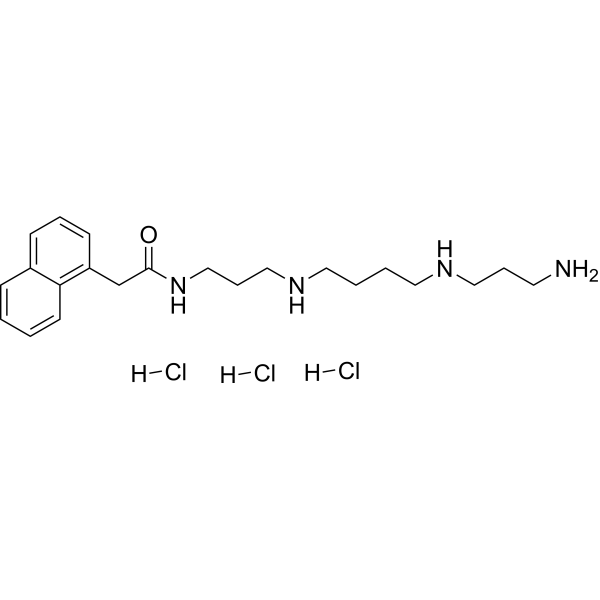
Naspm trihydrochloride
CAS No. 1049731-36-3
Naspm trihydrochloride( 1-Naphthylacetyl spermine trihydrochloride )
Catalog No. M26323 CAS No. 1049731-36-3
Naspm trihydrochloride is a synthetic analogue of Joro spider toxin and is an antagonist of calcium permeable AMPA (CP-AMPA) receptors.
Purity : >98% (HPLC)
 COA
COA
 Datasheet
Datasheet
 HNMR
HNMR
 HPLC
HPLC
 MSDS
MSDS
 Handing Instructions
Handing Instructions
| Size | Price / USD | Stock | Quantity |
| 2MG | 49 | Get Quote |


|
| 5MG | 78 | Get Quote |


|
| 100MG | Get Quote | Get Quote |


|
| 200MG | Get Quote | Get Quote |


|
| 500MG | Get Quote | Get Quote |


|
| 1G | Get Quote | Get Quote |


|
Biological Information
-
Product NameNaspm trihydrochloride
-
NoteResearch use only, not for human use.
-
Brief DescriptionNaspm trihydrochloride is a synthetic analogue of Joro spider toxin and is an antagonist of calcium permeable AMPA (CP-AMPA) receptors.
-
DescriptionNaspm trihydrochloride is a synthetic analogue of Joro spider toxin and is an antagonist of calcium permeable AMPA (CP-AMPA) receptors.(In Vitro):Naspm trihydrochloride selectively suppressed the inwardly rectifying and Ca(2+)-permeable AMPA receptors expressed in type II neurons. It had no effect on AMPA receptors in type I neurons. The blocking effect of Naspm trihydrochloride on the Ca(2+)-permeable AMPA receptors was use and voltage-dependent. When the effect of Naspm trihydrochloride reached a steady state, current responses induced by ionophoretic applications of kainate, a non-desensitizing agonist of AMPA receptors, in type II neurons were suppressed by Naspm trihydrochloride in a dose-dependent manner at -60 mV (IC50 0.33 microM, and Hill coefficient 0.94). The response to kainate recovered partially after washing out Naspm trihydrochloride. Naspm trihydrochloride did not affect the Ca(2+)-permeable AMPA receptors when the neuronal membrane was held at potentials more positive than +40 mV. Furthermore, the blockade by Naspm trihydrochloride which was attained at negative potentials was transiently removed by shifting membrane potential to +60 mV for 5 s together with a single ionophoretic application of kainate.
-
In VitroNASPM selectively suppresses the inwardly rectifying and Ca2+-permeable AMPA receptors expressed in type II neurons. It has no effect on AMPA receptors in type I neurons. At -60 mV, NASPM suppresses AMPA receptors in type II neurons with an IC50 value of 0.33 μM. The blocking effect of NASPM on the Ca2+-permeable AMPA receptors is use and voltage-dependent.
-
In Vivo——
-
Synonyms1-Naphthylacetyl spermine trihydrochloride
-
PathwayMembrane Transporter/Ion Channel
-
TargetiGluR
-
RecptorHuman Endogenous Metabolite
-
Research Area——
-
Indication——
Chemical Information
-
CAS Number1049731-36-3
-
Formula Weight479.92
-
Molecular FormulaC22H37Cl3N4O
-
Purity>98% (HPLC)
-
SolubilityIn Vitro:?H2O : 50 mg/mL (104.19 mM)
-
SMILESCl.Cl.Cl.NCCCNCCCCNCCCNC(=O)Cc1cccc2ccccc12
-
Chemical Name——
Shipping & Storage Information
-
Storage(-20℃)
-
ShippingWith Ice Pack
-
Stability≥ 2 years
Reference
1.Fernando Freitas, et al. Urinary 1-hydroxypyrene Is Associated With Oxidative Stress and Inflammatory Biomarkers in Acute Myocardial Infarction. Int J Environ Res Public Health
molnova catalog



related products
-
CFM-2
CFM-2, a potent and selective non-competitive antagonist of AMPAR (AMPAR), exhibits anticonvulsant activity across various seizure models.
-
Sunifiram
Sunifiram is a potent nootropic agent.
-
Rislenemdaz hydrochl...
Rislenemdaz (MK 0657;CERC 301) is a potent, orally bioavailable, brain‐penetrant, NR2B-selective NMDA receptor (GluN2B) antagonist with Ki and IC 50 of 8.1 nM and 3.6 nM respectively.



 Cart
Cart
 sales@molnova.com
sales@molnova.com


